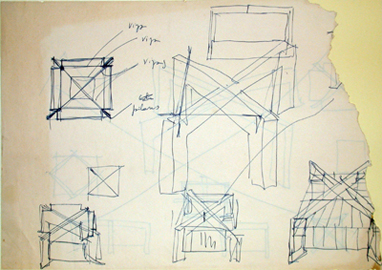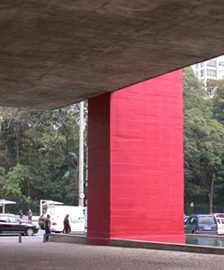You are in: Home page > Magazine Archive > Iconicity and limit form.

Giovanni Marras
Iconicity and limit form.
Recycling, a research hypothesis for architecture.

Lina Bo Bardi, MASP, São Paulo, 1957/1968, a study for the limit form, Instituto Lina Bo and P.M. Bardi.
At the beginning of the second millennium "to build in the built in" (Moneo, 2007) seems to be the prevailing condition design for architects and "Re - Cycle," in "strategies for architecture, the city and the planet," it seems today the most viable (Pippo Ciorra and others, 2012).
To build on the existing, beyond all the ethical and economic reasons and the ideological tendencies that whenever accompany the debut of new cultural habits, also corresponds to the need to explore new possible spatial configurations in which to live and work.
This new cultural awareness causes it to check for possible new cycles of life to abandoned buildings, damaged parts of the city, obsolete fragments of landscape, looking for a middle way between the bistoury and the bulldozer.
The What to do? Today, in these places – the abandoned factories of the Chair District (Torbianelli and others, 2012), the industrial areas along the river Isonzo, or parts of the Old City in Trieste, a first set of study areas - emerges as possible research hypotheses for a compositional experimentation in which the theme of the structure takes new iconic and symbolic significance.
A research where, after the schematic opposition between the (Italic) respectful homage to the identity value and historical and the succubus application of the (worldwide) paradigms of technological efficiency, memory and invention cease to be antagonist forces.
To know the potential of regeneration of the built environment through the tools of the composition (rarely used word by the copywriters of the recycling) introduces considerations on the duration of the architectural artifacts. Under the iconic profile and constructive, the possibility of "more lifes" in a building, is a function of the limit conditions of duration and reversibility of its constituent parts.
Given as outdated the naive statement, attributed by Giuseppe Samonà to certain semiology, that "architecture [...] and the objects do not communicate, but they work" (Samonà, 1978, 44-45), it seems more topical than ever the idea, almost prophetic, that the buildings can become for architects "an extraordinary manifestation of iconicity", in which the limit of the form, if assumed by reason of its functionality, syntactic, iconic and constructive, approximates to the archetype.
Lina Bo Bardi's studies about the bahian folk art (Bo Bardi, 1994), her chairs and the first sketches for the MASP's project (Girardi, 2004) that will lead to the creation of this new metropolitan iconicity of the "great void", the SESC, seen all together reaffirm the iconic glow of the form when it represents the labor necessary to its construction, as in playful construction assemblages of the bricoleur.
In an architectural organism this possibility of more lives is paradoxically subject to the existence of a significant stable form yet capable of representing, to the limit, the logic of construction of the building or parts of it with its own formal autonomy.
In the recognition of this sort of limit form takes on new meaning the contrast between the type and the model. If the type is defined in absentia, as "formal invariant which manifests itself in different examples and is on the level of deep structure of the form" (Martí Aris, 2006 12), the model is manifested in praesentia and coincides with the constructive truth of the building.
The limit form, which is obtained by composition and decomposition of a building (syntactic and conceptual, before physics), rather than being "an expression of something general and permanent" (Martí Aris, 2006 11), corresponds to this kind of "intrinsic incompleteness" that, at limit, is recognizable in the Greek temple as in the "log cabins" of the early settlers of North America (Brusegan, 2013), or in the homes of wood and mud in Brazil.
A cognitive process, very different from the diagnosis of conservative restoration, animated by a critical focus more creative and open-minded, "which tends to bring the qualities of the built in to the architectural structure: solid construction - responsiveness to the need - finiteness of the form" (Semerani, 1991, 100).
In this outlook, from the limit form of a building, one can experiment different modes of composition: inlay, overlay, extension, outer covering or inner. Compositional practices of modification of an existing structure with new buildings, useful to enable other methods of use.
Design operations that regenerate the life of the buildings creating new living spaces, a new architecture made of architectures, in which the identity of the original building is part of recognizable parts.
One way to conceive the project, in line with the Italian tradition contextualist, which was originally of BBPR, Carlo Scarpa, Franco Albini, Ignazio Gardella, that breaks disciplinary boundaries between restoration, museum design, architectural design and urban planning.
One way to critically understand and include in the project the different moments of the history of the building construction.
A process of formal and technical specification of the parts and elements of the limit form of the buildings always sensitive to "accept the discontinuity of historical time, to work on it, to 'work it' through successive constructions" in a "free game within of a strong knowledge of the texts "(Tafuri, 1984, 72-95). Techniques of composition and assembly, different than the montage (lasting legacy of the avant-garde), who work for inlay of architectural figures, according to the technical processes resulting.
Operations which trigger different compositional processes because of the connotation of the structures on which they operate, starting with the recognition of the durability of the elements of architecture and their functionality, especially involving the technical aspects and construction of the buildings. Starting from found materials and the interpretation of the expressive potential that they offer to the project is perhaps possible to consider the architectural composition as juxtaposition, layering and inlay of different figures, in a process in which the formal and constructive relationships between text and pretext can regenerate the life and the meanings of the buildings.
If it is true that, beyond a schematic opposition between old and new, the architecture can be understood as "two sets of parts, one long-term and the other easily replaceable" (Lynch, Kevin, 1992 236-237), perhaps after a long season of figurative exuberance in which architects have focused more on the skin of the buildings, it is time to return to deal with that part of the "long-term", bringing back the architecture to a principle of authenticity.
Riferimenti bibliografici
Moneo, Rafael. (2007). Costruire nel costruito. Torino: Allemandi & C.
Gangemi, Virginia. (2004), La cultura progettuale del riciclaggio in architettura: prospettive ed orientamenti. In Gangemi V. et al, Riciclare in architettura. Scenari innovativi della cultura del progetto. Napoli: Clean, 10.
Torbianelli, Vittorio et al. (2012). Oltre le fabbriche. Visioni evolutive per il distretto della sedia. Trieste: EUT.
Samonà, Giuseppe. (1978), Il significato storico del presente e si suoi problemi nell’unità del linguaggio architettonico”. In G. Samonà, L’unità architettura urbanistica. Scritti e progetti 1929 – 1973. Milano: Franco Angeli, 44-45
Bo Bardi, Lina (1994). Tempos de Grossura: O design no impasse. Sao Paulo: Instituto Lina Bo e P.M. Bardi.
Girardi, Giorgio (2004). Il MASP 1957 – 1968. Gallo, Antonella et al. In Lina Bo Bardi architetto. Venezia: Marsilio, 99 – 119.
Martí Arís, Carlos (2006). Le variazioni dell’identità. Il tipo in architettura. Milano: CittàStudi edizioni, 12.
Semerani, Luciano (1991). Sinan. Il restauro creativo. In Semerani, Luciano. Passaggio a nord-est. I quaderni di Lotus, Milano: Electa.
Kevin Lynch (1992). Deperire: rifiuti e spreco nella vita di uomini e citta. Napoli: Cuen.
Tafuri, Manfredo (1984). Il frammento la ‘figura’, il gioco. Carlo Scarpa e la cultura architettonica italiana. In Carlo Scarpa, Opera completa, Milano: Electa, 72 – 95.
Brusegan, Elisa. L’architettura regionale. Lewis Munford, William Wurster e la tradizione della Bay Area, Venezia: Tesi di Dottorato di Ricerca in Composizione Architettonica, XXIV ciclo.
Keywords
composition, recycling, architecture
Giovanni Marras (1963), since 2004 associate professor of architecture and urban design at the University of Trieste, 1994-2004 researcher at the Department of Architectural Design IUAV - Venice, in 1993 PhD in Architectural Composition at IUAV - Venice.














